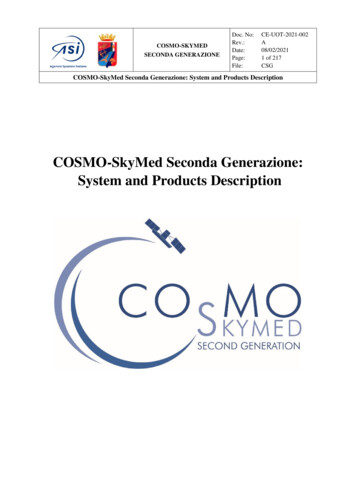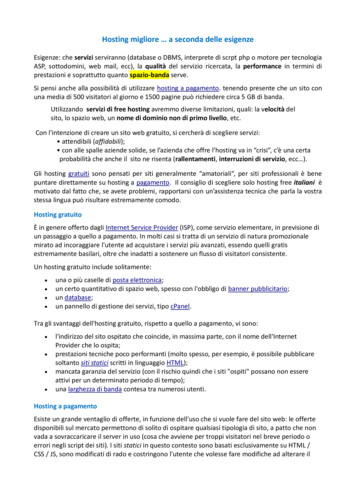
Transcription
COSMO-SKYMEDSECONDA GENERAZIONEDoc. No:Rev.:Date:Page:File:CE-UOT-2021-002A08/02/20211 of 217CSGCOSMO-SkyMed Seconda Generazione: System and Products DescriptionCOSMO-SkyMed Seconda Generazione:System and Products Description
COSMO-SKYMEDSECONDA GENERAZIONEDoc. No:Rev.:Date:Page:File:CE-UOT-2021-002A08/02/20212 of 217CSGCOSMO-SkyMed Seconda Generazione: System and Products DescriptionINDEX1.SCOPE . 52.ACRONYMS. 53.COSMO-SKYMED MISSION OVERVIEW . 73.1.Mission. 73.2.Infrastructure . 83.2.1.Space Segment . 83.2.2.Ground Segment . 123.3.Deployment Plan . 134.SYSTEM PERFORMANCES . 144.1.Acquisition Performances . 144.2.Time Performances . 144.2.1.Input and Assumptions . 144.2.2.CSG Satellites Revisit Time . 144.2.3.CSG Satellites Information Age . 144.3.Orbital Parameters . 154.3.1.Interferometric revisit . 165.ACQUISITION MODES . 175.1.Standard Acquisition Modes . 195.1.1.Standard Spotlight Modes . 195.1.2.Standard Wide Field Modes . 205.1.3.Polarization Characteristics . 215.1.4.Standard Acquisition Modes Image Quality Summary . 225.1.1.Beams and Incidence Angles . 235.2.Non-Standard Acquisition Modes . 285.2.1.Non Standard Operational modes . 295.2.1.1. DI2S Spotlight-2 Multi-Swath . 295.2.1.1. Spotlight on theatre . 306.PRODUCTS DESCRIPTION. 326.1.Standard products . 346.1.1.Level 0 Product . 366.1.2.Level 1A Product . 376.1.2.1. SCS B Product . 386.1.2.2. SCS U Product . 386.1.2.3. SCS F Apodized Product (non-standard) . 396.1.2.4. ScanSAR Mode . 396.1.3.Level 1B Product . 406.1.3.1. DGM B Product . 406.1.3.2. QLK B Product . 416.1.3.3. Special DSM W Product . 416.1.3.4. DGM F and DSM F Apodized Product (non-standard) . 416.1.3.5. ScanSAR Mode . 416.1.4.Level 1C Product . 41
COSMO-SKYMEDSECONDA GENERAZIONEDoc. No:Rev.:Date:Page:File:CE-UOT-2021-002A08/02/20213 of 217CSGCOSMO-SkyMed Seconda Generazione: System and Products Description6.1.4.1. GEC B Product. 416.1.4.2. GEC F Apodized Product (non-standard) . 426.1.5.Level 1D Product. . 426.1.5.1. GTC B Product. 426.1.5.2. GTC F Apodized Product (non-standard) . 436.2.Non Standard Products Higher Level Products . 456.2.1.Quick Look Product . 466.2.2.Speckle Filtered Product . 476.2.3.Coregistered Product . 476.2.4.Interferometric Product . 496.2.5.Coherence Product . 516.2.6.DEM Product . 516.2.7.Mosaicked product. 536.2.8.Cropped Product . 547.ON-DEMAND SERVICES . 557.1.7.2.7.3.7.4.7.5.7.6.8.Acquisition Requests with diversified priorities . 55Very Urgent Service . 55Last Minute Planning. 55Near Real Time data delivery . 56On-demand area coverage. 56Service Requests from the Catalogue. 56PRE-PROGRAMMED MONITORING . 578.1.8.2.Italian territory monitoring (Map Italy) . 57Automatic background mission . 579.CIVILIAN USERS ACCESS TO THE SYSTEM . 5810.STANDARD PRODUCTS FORMAT DESCRIPTION . 5910.1. HDF5 format . 5910.1.1.Groups . 5910.1.2.Datasets . 6010.1.2.1. Dataset header . 6010.1.2.2. Name . 6010.1.2.3. Datatype . 6010.1.2.3.1. Dataspace . 6110.1.2.3.2. Storage layout . 6210.1.3.HDF5 Attributes . 6210.1.4.Products Organization . 6210.1.5.Naming Convention . 6210.1.6.Hierarchies organization . 6510.1.7.Graphical representation of the hierarchical organization for each Instrument Mode and ProcessingLevel . 7010.1.8.Quick Look layer . 7410.1.9.Ancillary information organization. 7510.1.10.Date Format . 7510.1.11.Data storage policy . 7610.2. Tiff Format . 77
COSMO-SKYMEDSECONDA GENERAZIONEDoc. No:Rev.:Date:Page:File:CE-UOT-2021-002A08/02/20214 of 217CSGCOSMO-SkyMed Seconda Generazione: System and Products Description10.3. JPEG Format Specifications. 9210.3.1.File Format Specifications . 9210.3.1.1. JPEG Compression Steps . 9210.3.1.2. File Structure . 93Appendix APRODUCT ATTRIBUTES . 94
COSMO-SKYMEDSECONDA GENERAZIONEDoc. No:Rev.:Date:Page:File:CE-UOT-2021-002A08/02/20215 of 217CSGCOSMO-SkyMed Seconda Generazione: System and Products Description1.SCOPEScope of the Document is to provide a COSMO-SkyMed Seconda Generazione overview, describing the overall missionand its performances, pointing out the main differences and improvements with respect to the COSMO-SkyMed FirstGeneration and describing the Products that are generated from it.2.ACRONYMSACRONYMARAcquisition RequestsASIAgenzia Spaziale ItalianaAIVAssembly, Integration and Verification (Assemblaggio, Integrazione e Verifica)ANSAVSAgenzia Nazionale per la SicurezzaAvionic SubsystemCALCALibrazioneCDMClient Deposit ManagerCGSCore Ground SegmentCPCMMission Planning CenterCSGCOSMO-SkyMed di Seconda GenerazioneCSKCOSMO-SkyMed (1aGenerazione)DEEDigital Electronics EquipmentDEMDigital Elevation ModelDI2SDiscrete Stepped StripEOEPSEarth ObservationElectrical Power SubsystemFMFlight ModelGCPGround Control PointGEMGeocoded Elevation MatrixGFNGlobal Futures NetworkGIMGeocoded Incidence MaskGPSGlobal Positioning SystemG/SGround StationHPHigh PriorityIEMInteroperability, Expandibility, Multimission/MultisensorIRFImpulse Response FunctionLMPLast Minute PlanningMoDItalian Ministry of Defence
COSMO-SKYMEDSECONDA GENERAZIONEDoc. No:Rev.:Date:Page:File:CE-UOT-2021-002A08/02/20216 of 217CSGCOSMO-SkyMed Seconda Generazione: System and Products DescriptionACRONYMMSMulti-Swath (modality)NRTNear Real TimeOBCOn-Board ComputerOROptimized ResolutionOSPDHTOptimized SwathPayload and Data Handling Transmission S/SPLMPayLoad ModulePPPrivileged PriorityPPMProPulsion ModulePRFPulse Repetition FrequencyPRIPulse Repetition IntervalPRPPropulsion SubsystemQLKQuick Look ProductRFRFERadio Frequencythe Radio Frequency EquipmentRTNRoutineSARSynthetic Aperture RadarSASSAR Antenna SubsystemSESSAR Electronic SubsystemSSEService Support ElementSVMSerVice ModuleSRTStructure S/SSSOSun Synchronous OrbitS/STCSSubsystemThermal Control S/STPSTelecommand Protection SystemTT&CUGSTelemetry, Tracking & Control SubsystemUser Ground SegmentUMUser ManageUTMUniverso Traverso MercatoreVUVery Urgent
COSMO-SKYMEDSECONDA GENERAZIONEDoc. No:Rev.:Date:Page:File:CE-UOT-2021-002A08/02/20217 of 217CSGCOSMO-SkyMed Seconda Generazione: System and Products Description3.COSMO-SKYMED MISSION OVERVIEWCOSMO-SkyMed (COnstellation of small Satellites for Mediterranean basin Observation) Mission is the largest Italianinvestment in Space Systems for Earth Observation, commissioned and funded by the Italian Space Agency (ASI) andthe Italian Ministry of Defence (MoD). COSMO-SkyMed is “natively” conceived as a Dual-Use (Civilian and Defence)end-to-end Earth Observation System. It aims to establish a global service supplying provision of data, products andservices compliant with well-established international standards to the Scientific Community, especially working in theEarth Science field, as well as to the Technical Community of developers of value added products and services,particularly in the fields of risk management, environmental monitoring, natural resources management and defence /intelligence.COSMO-SkyMed mission will then offer an efficient response to actual needs of Earth Observation Market providing anasset characterized by full global coverage, all weather, day/night acquisition capability, higher resolution, higheraccuracy (geo-location, radiometry, etc.), superior image quality, fast revisit/response time, interferometric/polarimetriccapabilities and quicker-and-easier ordering and delivery of data, products and services.COSMO-SkyMed First Generation consists of a constellation of four Low Earth Orbit mid-sized satellites, each equippedwith a multi-mode high-resolution Synthetic Aperture Radar (SAR) operating at X-band and fitted with particularlyflexible and innovative data acquisition and transmission equipment. The system is completed by dedicated full-featuredGround infrastructures for managing the constellation and granting ad-hoc services for collection, archiving anddistribution of acquired remote sensing data. First generation deployment started in 2007 and the system is fully operativesince 2010.COSMO-SkyMed Seconda Generazione is based on 2 enhanced SAR Satellites, placed on the same orbit of the FirstGeneration, and on an improved Ground Segment.As already done for the First Generation, also for the Seconda Generazione particular emphasis has been put on DualUse Mission Planning functionality in order to optimize system utilization and fulfilling at the same time different userclasses needs.Additionally, COSMO-SkyMed Mission allow the access at different Earth Observation Systems from Civilian Partners(Institutional, Scientific and Commercial) and Defence Partners though an integrated User Ground Segment. To thispurpose, the system has been conceived in order to pursue a multi-mission approach thanks to its intrinsic Inter-operabilitywith other EO missions and Expandability towards other possible partners, also with different sensors typologies, toimplement an integrated space-based system providing Earth Observation integrated services to large User Communitiesand Partner Countries (IEM capability). These features designate COSMO-SkyMed as a system capable to provide“Institutional Awareness” information in support to decisions in preventing and managing world-wide crisis.3.1.MissionIn the frame of COSMO-SkyMed infrastructure, COSMO-SkyMed Seconda Generazione aims to provide servicecontinuity to the first generation constellation, while improving performances, functionalities and system services for theEarth Observation users’ community.The mission objectives of COSMO-SkyMed Seconda Generazione are related to a space mission having a dual nature(i.e. capable to satisfy civilian and defence customers) able to provide information and services in several applicativefield, such as risk management applications, cartography and planning applications, agriculture, forest, hydrology,geology, marine domain, archaeology etc.The high level requirements lead to the development of a system with the following main capabilities: Large amount of daily acquired images; Satellites worldwide accessibility;
COSMO-SKYMEDSECONDA GENERAZIONEDoc. No:Rev.:Date:Page:File:CE-UOT-2021-002A08/02/20218 of 217CSGCOSMO-SkyMed Seconda Generazione: System and Products Description All weather and Day/Night acquisition capabilities;Very fast interval between the finalization of the user request for the acquisition of a certain geographic area andthe release of the remote sensing product (System Response Time);Very fine image quality (e.g. spatial and radiometric resolution);Flexible image spatial resolution vs. size acquisition, starting from sub-meter resolution;Capability to be cooperating, interoperable, expandable towards other EO missions, acting as multi-missionsystem able to provide EO integrated services to large User Communities on a worldwide scale.3.2.InfrastructureCOSMO-SkyMed is the main component of the Italian infrastructure for Earth Observation (EO), which is a System ofSystems, expandable, which can incorporate or interface with any kind of EO Mission. It provides services both to Civilianand Defense Users (dual-use).The first generation constellation ̶ 4 Satellites carrying an X-band Synthetic Aperture Radar (SAR) ̶ has been fullyoperative since 2010. The evolution of the Second Generation is based on 2 enhanced SAR Satellites and an improvedGround Segment.Figure 1 - COSMO-SkyMed Infrastructure3.2.1. Space SegmentCOSMO Seconda Generazione Space Segment is based on 3-axis stabilized satellites orbiting in Sun Synchronous Orbit(SSO). Its state of art technology main features are:
COSMO-SKYMEDSECONDA GENERAZIONEDoc. No:Rev.:Date:Page:File:CE-UOT-2021-002A08/02/20219 of 217CSGCOSMO-SkyMed Seconda Generazione: System and Products Description A side looking X-band SAR payload capable to access both right and left with respect to the flight directionwith a 20 - 60 incidence access area capability corresponding to an on ground access area of about 2 x 650 Kmwide;A Payload Data Handling and Transmission (PDHT) comprising all the functions necessary for the real-timeacquisition, storage and handling of SAR data generated by the Payload, and for their transmission to the groundstation;A 3 axis stabilization Platform, with steering capabilities on each axis, high pointing accuracy and knowledgeand real time orbit determination;2 solar array wings that provide power generation for the platform and the SAR payload;A propulsion system for orbit control.The satellite pictorial representation is given in the following Figure 2; its physical architecture consists of the subsystemsand payloads listed below: Payload, composed by:̶ SAR Instrument̶ Payload and Data Handling Transmission S/S (PDHT) Platform, composed by the following Subsystems:̶ Thermal Control S/S (TCS)̶ Structure S/S (STR)̶ Propulsion Subsystem (PRP)̶ Avionic Subsystem (AVS)̶ Telemetry, Tracking & Control Subsystem (TT&C)̶ Electrical Power Subsystem (EPS)̶ Harness S/S (DC & Pyro)̶ Telecommand Protection System (TPS)Figure 2 - COSMO-SkyMed Satellite (deployed and stowed configuration)PlatformThe Platform general architecture is based on the PRIMA concept which foresees three main modules structurally andfunctionally decoupled to allow the parallel modules integration and testing activities up to the satellite final integration.The modules are: the SerVice Module (SVM) carrying only bus units apart from the propulsion ones;
COSMO-SKYMEDSECONDA GENERAZIONEDoc. 0 of 217CSGCOSMO-SkyMed Seconda Generazione: System and Products Description the ProPulsion Module (PPM) carrying all the propulsion items connected by the pipelines; the PayLoad Module (PLM) carrying al the payload equipment including the pertinent appendagesPRIMA platform family has an extensive heritage in already flown programs, with 5 Satellites already fully operational(Radarsat-2, COSMO-SkyMed FM-1, FM-2, FM-3 and FM-4 with a total of more than 110,000 flight hours), in which ithas successfully demonstrated the flexibility of use, low management costs and the ability to adapt to changing operationalconditions.To fulfil its functions, the Platform is organized in Subsystems, as briefly recalled hereafter:On boardSubsystemAvionic S/SMain Functions / Equipment-Attitude Control, including sensor and actuators driving functionsOn board Software processing, including Operating System, Data Handling, SoftwareApplications, Failure Detection Isolation and Recovery.Navigation Tasks, orbit predictionAutonomy functionsProcessor Module Reconfiguration LogicTC and housekeeping TM data handling-Sunlight photo-voltaic conversion in electrical power by means of Solar ArraysUnregulated Power Bus clamped to Battery voltageEnergy Storage to support SAR and Eclipse operationsPower conditioning, distribution and switching;Eclipse and Battery management (under SMU control)Power Supply for SAR P/L antenna and its survival heatersPyrotechnic devices operations-Orbit Control by means of Six 1N hydrazine Reaction Control Thrusters, Hydrazine Tank,pipes, valves and Pressure transducer.TT&C S/S-S/B Transponders to support TT&C operationsThermal S/S-Thermal control of on board equipment. Active and passive elements are included such asHeat Pipes, Heaters, Reflectors and Insulators.Bus thermal controller implemented by softwarePayload Thermal state monitoring-Structural support and interface with launch vehicleStiffness and resistanceThermo-elastic stabilityEMC radiated electrical fields protection for internal unitsSAR Antenna supportAppendage hold-down points and release mechanisms;ElectricalPower S/SPropulsion S/SStructureTable 1 - Platform S/S's Main Functions
COSMO-SKYMEDSECONDA GENERAZIONEDoc. 1 of 217CSGCOSMO-SkyMed Seconda Generazione: System and Products DescriptionThe enhancement of the Platform at architectural level is the result of an optimization process performed at eachsubsystem level, on the basis of the CSK lesson learned and on the technological improvements already adopted in theframe of previous heritage programs.PayloadCSG Payload is composed by: SAR Instrument Payload and Data Handling Transmission S/S (PDHT)The SAR instrument is based on a deployable planar phased array antenna (SAS) and a central electronics (SES) forsignal generation, reception and instrument command and control.The approach to the instrument design takes into account the heritage and know-how acquired within the SAR2000 andCOSMO-SkyMed First Generation programs, and capitalise the lesson learned during of the in-flight operations.The SAR instrument, operating in the X-band with horizontal and vertical polarization and with the capability toelectronically steer the beam in both the azimuth and the elevation planes, is capable to operate in different modessatisfying different user needs, in particular: Stripmap (with single, dual and quad-pole capability) PingPong (with four polarization capability in burst mode) Spotlight (with single and dual polarization capability) ScanSAR (with single and dual polarization capability)STRIPMAP-PINGPONGMODESSPOTLIGHTS MODESSCANSAR MODESFigure 3 - CSG SAR Operative ModesThe SAR instrument is composed of two major subsystems: the SAR Electronic Subsystem (SES) which in turn is composed by̶ the Radio Frequency Equipment (RFE)̶ the Digital Electronics Equipment (DEE)̶ RF and DC harness The SAR Antenna Subsystem (SAS)The Payload Data Handling and Transmission (PDHT) subsystem manages the handling and transmission of datagenerated by the SAR on-board satellite payload; it is designed also to provide the capability to acquire, store anddownlink data from additional sources (i.e. GPS raw data).
COSMO-SKYMEDSECONDA GENERAZIONEDoc. 2 of 217CSGCOSMO-SkyMed Seconda Generazione: System and Products DescriptionSAR data are supplied by the payload in the form of CCSDS Source Packets. Auxiliary data are supplied by the On-BoardComputer (OBC) through the specific packets format.The main improvements respect COSMO First Generation are summarized below:SAR:the observation sensor, that is the Synthetic Aperture Radar (SAR), capable to improve the spatialresolution of the (narrow field) images by a factor 2, providing also multi-polarization, and greatversatility of narrow and wide field images at extremely high operational profiles. The technologyinnovations necessary to sustain such a performance are deeply interesting all SAR elements, realizingcompletely renewed design of SAR central electronics and active phased array antenna with respect toCSK First Generation.PDHT:the basic PDHT S/S design will take benefit from the development currently on-going in the frame ofSentinel 1 program. The on board Payload Data Handling and Transmission (PDHT) will be capable todouble the performances of the PDHT of the CSK first generation both in terms of data volume handledon-board and transmission throughput to ground. This technology innovation also interests allcomposing elements of PDHT, such as memory technologies for on-board data storage, on-board C&Csoftware, data encryption, modulation s
CPCM Mission Planning Center CSG COSMO-SkyMed di Seconda Generazione CSK COSMO-SkyMed (1aGenerazione) DEE Digital Electronics Equipment DEM Digital Elevation Model DI2S Discrete Stepped Strip EO Earth Observation EPS Electrical Power Subsystem FM Flight Model GCP Ground Control Point GEM Geocoded Elevation Matrix










